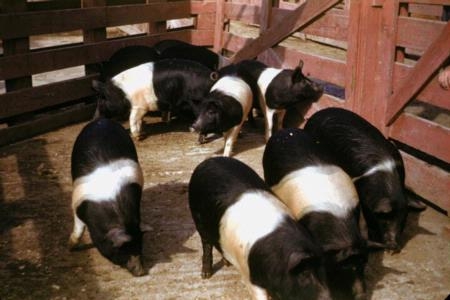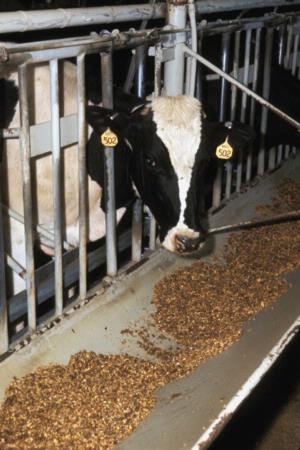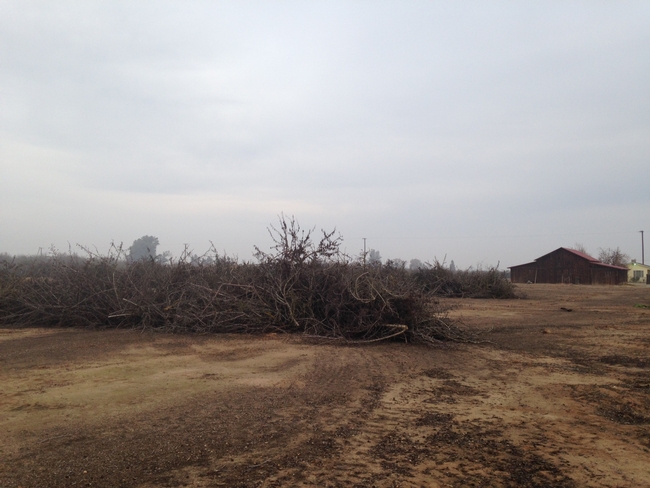Posts Tagged: air quality
UC scientist studies an alternative to burning old trees when replacing an orchard
Holtz has been pioneer in ag burn alternatives throughout his 26-year-career with UCCE, and going back still further on his family almond farm near Modesto. Beginning in the early 1990s, Holtz and his father experimented with chipping almond prunings instead of burning them, long before air quality regulations required wide implementation of the practice.
When Holtz heard a four-acre stone fruit orchard was slated for removal at the UC Kearney Agricultural Research and Extension Center in Parlier seven years ago, he took the opportunity to study the impact of grinding up and incorporating the whole trees before planting a new orchard.
“When an orchard is pushed out, there is about 100 tons per acre of organic matter that is taken out of the system,” Holtz said. “My previous research showed positive results from organic matter. Our San Joaquin Valley soils are typically critically low in organic matter. Why remove it if it is good for the soil?”
A local company was contracted to grind up and incorporate the trees using an Iron Wolf, essentially a 50-ton rototiller, in selected research plots. (See video below.) At first, Holtz was concerned that the Iron Wolf left “firewood-sized” chucks of wood in the plots, pieces much larger than he had studied before in his wood chipping research. But the worry turned out to be unfounded.
In comparison plots, trees were pushed together and burned. The ashes later were spread out on the soil. All the plots were fertilized at the normal rate.
Over the years, Holtz has compared laboratory analyses of the nutrients available to the trees in the soil and nutrients in the leaves. Initially, the burn treatments had more nutrients available. The second year, nutrient availability was about equal. Leaf analyses in the third year began to show a higher level of nutrients in the leaves of trees growing in the area where old trees had been ground up and incorporated. In the fifth and sixth years, Holtz didn't see any differences in growth, but data suggests slightly higher yields where the trees were ground up.
“A lot of growers feared if we added that much carbon to the soil, the microbes breaking down the organic matter would tie up nitrogen and the trees would be stunted,” Holtz said. “But the research results suggest that the trees will do just as well or better in the presence of the additional organic matter.”
One potential barrier to grinding up old trees is the cost. Holtz said the Iron Wolf treatment cost $800 per acre and it is not readily available in the San Joaquin Valley. Burning is nearly cost-free for the farmer, but contributes to air pollution and is highly regulated.
Another option for almond farmers preparing to remove an orchard and replant is employing a large tub grinder, which leaves much finer particles of wood than the Iron Wolf, is more readily available but more expensive. Holtz said he hopes that growers in the future will receive incentives to grind up their orchards and incorporate the wood chips into their soils before they plant a second- or third-generation orchard.
“I'm trying to find growers who would be interested in trying this approach to conduct on-farm research,” Holtz said.
In the video below, the Iron Wolf grinds up whole trees and incorporates the organic matter into the soil:
An initiative to enhance competitive and sustainable food systems is part of the UC Division of Agriculture and Natural Resources Strategic Vision 2025.
Kern County UCCE hosts air quality study
A 60-foot tower near the UC Cooperative Extension office on South Mt. Vernon Avenue in Bakersfield has been built to hold instruments aloft for air quality studies in the area, the Bakersfield Californian reported.
Researchers from around the country are conducting the studies to gain a deeper understanding of the environment and to inform air quality regulatory policy.
"You need to measure what's in the air, and then from that you go back and look at crafting regulatory policy," UCCE farm advisor John Karlik was quoted. "But science has to precede policy."
The tower is hosted by the UC Cooperative Extension and funded by the California Air Resources Board.
Bakersfield was chosen as a site for the project, which began in May and runs through the end of June, because of its problems with air quality and its relatively strong sources of atmospheric compounds, the article said.
The participating scientists - representing UC Berkeley, University of Wisconsin and University of Miami - have already begun assessing data.
"It's all about how we put those data into a larger framework," Karlik was quoted. "We think it's of broader public interest."
Not a lot of greenhouse gas is from animal ag
There's been some confusion in recent years about the impact of animal agriculture on global warming. UC Davis Cooperative Extension air quality specialist Frank Mitloehner will share his findings on the subject this month during a free webinar on the eXtension website, according to an article in Pork magazine.
The 2006 United Nations report "Livestock's Long Shadow" said the livestock sector is responsible for 18 percent of greenhouse gas emissions, a higher share than transportation. Mitloehner said livestock's contribution is more like 3 percent, yet wide distribution of the misinformation has put Americans and others on the wrong path toward solutions.
The webinar, which will include information from Mithoehner's report "Clearing the Air: Livestock's Contribution to Climate Change," is at 11:30 a.m. Pacific Time June 11. Forum participants will have the opportunity to ask questions, post comments, upload photos and share their experiences. All the details, including links to background information and to the webinar, are in this eXtension flyer.

Black and white swine.
Valley ozone story takes off
Research by UC Davis scientists that revealed a substantial amount of San Joaquin Valley ozone is generated by animal feed is getting wide coverage in the news media. Google News reported 126 articles on the subject.
Many newspapers ran the Associated Press version of the story, written by Fresno-based Tracie Cone. She reported that the study — funded by the U.S. Department of Agriculture, California Air Resources Board and the San Joaquin Valley Air Pollution Control District — was initially intended to measure the impact of animal manure, urine and flatulence on ozone levels.
However, the researchers discovered that millions of tons of fermenting cattle feed bears greater responsibility.
Mark Grossi of the Fresno Bee noted in his story that the study was published last month in the journal Environmental Science & Technology. This week's flurry of interest was generated by an April 21 news feed from the American Chemical Society press office. ACS publishes the journal.
In his story, Grossi wrote that the cattle feed explains only half of the Valley's ozone problem. The other half, Nitrogen oxide, or NOx, comes from vehicles. San Joaquin Valley Air Pollution Control District believes NOx is more important to control, the Bee article said.Meanwhile, Capital Press reported yesterday that the U.S. Environmental Protection Agency has rescinded its long-standing exemptions for agriculture under emission-control rules.
"Air quality in the San Joaquin Valley is consistently among the worst in the nation," said Deborah Jordan, director of the Air Division for the EPA's Pacific Southwest region, in a statement. "New and modified facilities will now be subject to the most stringent requirements, which will contribute to the health of our communities."

A dairy cow eats its rations.
San Francisco meeting generates research buzz
A meeting this week of the American Chemical Society turned two interesting UC research projects into headline news.
UC Davis nutrition professor Paul Davis reported that walnuts slowed prostate tumors by 30 percent to 40 percent in mice, according to a UPI article. The dose was equivalent to 2.5 ounces for a typical man. Not only was prostate cancer growth reduced, but the mice had lower blood levels of a protein that is strongly associated with prostate cancer.Completely unrelated research presented at the meeting, also from UC Davis, questioned an often-quoted UN statistic that said animal agriculture produces 18 percent of greenhouse gas emissions, more than all transportation combined.
Air quality specialist Frank Mitloehner says the U.N. reached its conclusions for the livestock sector by adding up emissions from farm to table, including the gases produced by growing animal feed, animals' digestive emissions, and processing meat and milk into foods. However, for transportation it only considered emissions from fossil fuels burned while driving, according to a CNN story.
"This lopsided 'analysis' is a classical apples-and-oranges analogy that truly confused the issue," Mitloehner was quoted in the original UC Davis news release announcing his results.
At least one blogger wasn't fully convinced that the world can go back to eating meat guilt free. The writer of Guardian UK Environment Blog, Leo Hickman, wondered why more media outlets hadn't reported that Mitloehner receives a significant amount of research funding from the meat industry."I'm not saying that Mitloehner is a bought-off scientist in the pocket of Big Beef. . .," Hickman wrote. "My beef is that this funding information has not been deemed worthy of inclusion in the reports and blogs that have been so quick to leap on Mitloehner's findings as, in their eyes, further proof that environmentalists are just a bunch of unscientific cranks."
The American Chemical Society's national conference concludes today.

Frank Mitloehner


